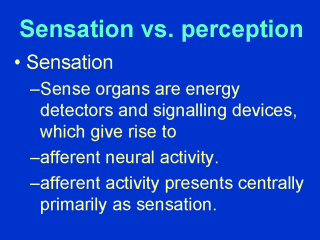 |
Sensation
arises from the activation of peripheral energy detectors (senses), which in turn send
afferent impulses to the CNS, where it presents in the Primary Projection Areas (these
correspond to different parts of the cortex - occipital for vision, superior temporal for
audition, and so on). From these areas, secondary and tertiary activity occurs in the
immediately proximal and more distal cortex surrounding these PPAs. The primary activity
in PPAs is associated with sensation, but it is the secondary and particularly the
tertiary activity that is associated with the more complex, synthetic perception activity.
(However, keep in mind that this distinction is, of course, artificial because the brain
works as an integrated unit). AR Luria (1979) was
able to outline the three functional units of the brain (a unit for the maintenance of
cortical arousal and tone in the brainstem and ascending reticular activating system, a
unit for the reception of sensory information (which we are focusing on in this lecture)
and a unit for the production of outputs, such as speech, and non-linguistic motor acts).
Each functional unit was ascribed three levels of specialization, based on the
architectonics of the tissues, primary, secondary and tertiary zones. These correspond not
only to anatomical and physiological characteristics, but also to the neuro-psychological
functions these zones underpin. |
